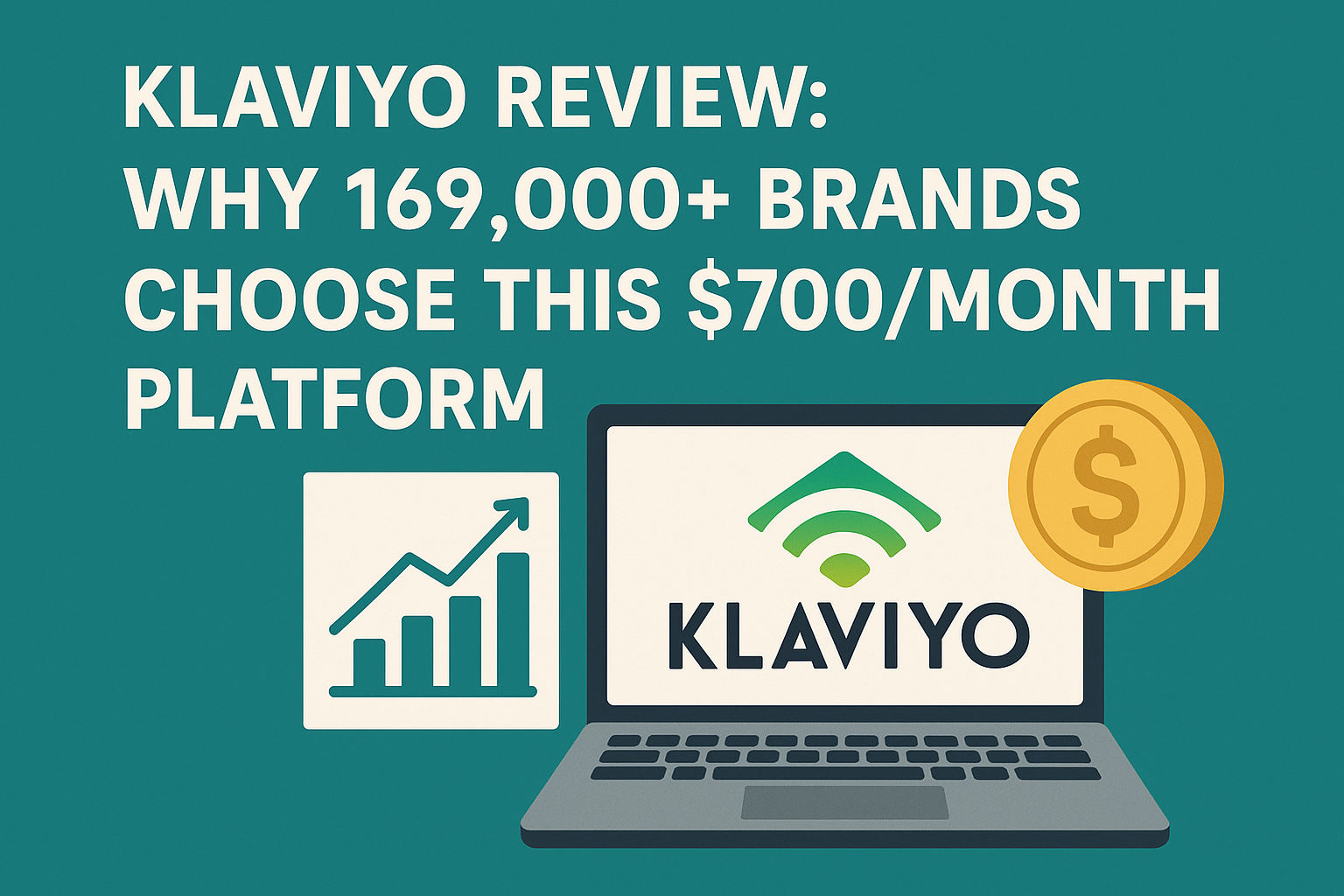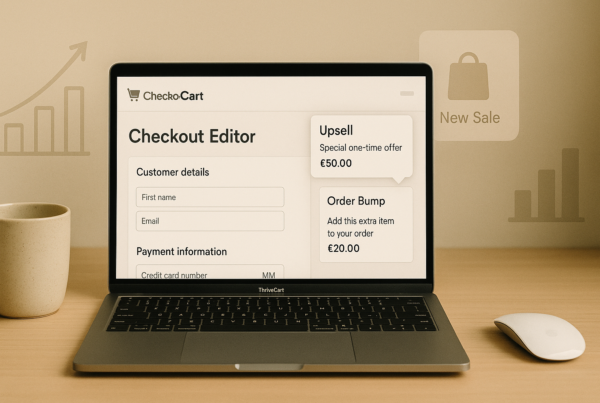Looking for an honest Klaviyo review before committing to this popular email marketing platform? Founded in 2012, Klaviyo has grown from a startup to a powerful marketing solution that powers thousands of e-commerce brands worldwide. With an impressive 4.7 overall rating and 85% of users giving it five stars, this platform has captured merchants’ attention.
Regarding pricing, Klaviyo offers three distinct tiers to accommodate businesses of all sizes. You can start with their Free plan that caps your contacts at 250 with up to 500 monthly emails, or upgrade to the Email tier beginning at $20 monthly for 500 contacts. For those needing email and SMS capabilities, the Email + SMS plan starts at $35 per month and includes 1,250 SMS/MMS credits. As your contact list grows, so does the monthly cost; for instance, 50,000 contacts on the Email tier would cost $790 per month.
In this comprehensive Klaviyo review, you’ll discover everything you need to know about Klaviyo pros and cons, its powerful automation capabilities, advanced segmentation tools, and whether this platform is truly worth the investment or if digging into Klaviyo alternatives might better suit your business needs.
What is Klaviyo, and who is it for?

Klaviyo stands out in the crowded email marketing landscape as a specialized B2C CRM (Customer Relationship Management) platform built specifically for e-commerce businesses. Unlike generic marketing tools, Klaviyo combines marketing, service, and analytics capabilities into a unified platform that focuses on creating lasting customer relationships.
1. Overview of Klaviyo software
At its core, Klaviyo is a comprehensive marketing automation platform that helps businesses create personalized marketing experiences through multiple channels. Currently powering over 169,000 relationship-driven brands, Klaviyo acts as a customer data platform that gathers information from various sources, such as website activity and purchase history, to build detailed customer profiles.
The platform offers a strong suite of features, including:
- Email marketing with drag-and-drop editors and dynamic product blocks
- SMS marketing with compliance management
- Mobile app marketing capabilities
- Customer segmentation and targeting
- Automated flows based on customer behavior
- Analytics and reporting tools
Klaviyo’s ability to integrate seamlessly with popular eCommerce platforms makes it particularly valuable. While it’s well-known for its Shopify integration, Klaviyo works effectively with WooCommerce, BigCommerce, Magento, and Wix through its extensive library of 350+ pre-built integrations.
2. Best-suited business types
Klaviyo excels for businesses leveraging data-driven marketing. Direct-to-consumer brands benefit from advanced segmentation, tailoring messages to purchase history and engagement. Subscription businesses automate renewals and upsells, reducing churn. Fashion, beauty, and health supplement companies enjoy Klaviyo’s user-friendly interface and pre-built templates.
Specialty food producers, eCommerce-driven organizations, and high-end retailers also value Klaviyo’s powerful segmentation for personalized marketing. These capabilities enable precise targeting, helping brands stand out in competitive markets while driving customer engagement, loyalty, and increased revenue through tailored experiences and automated campaigns.
3. How it compares to traditional email tools
Klaviyo differs from conventional email marketing platforms in several fundamental ways. First, it provides a more integrated and data-driven approach than traditional email tools, which often lack the same automation and personalization capabilities. When comparing Klaviyo vs ActiveCampaign, this eCommerce-specific focus becomes particularly evident in their feature sets and targeting capabilities.
Furthermore, Klaviyo’s focus on eCommerce includes specialized features like abandoned cart emails, product suggestions, and order confirmations built into the platform. This eCommerce-specific functionality eliminates the need for additional integrations or workarounds.
- Klaviyo offers advanced segmentation capabilities beyond basic list management, allowing audience segments to be created based on various customer data points such as purchase history, browsing behavior, and predictive metrics (e.g., churn risk).
- Klaviyo provides unlimited historical data access (“no look-back limits”), enabling marketers to analyze customer behavior across their entire history without additional costs, unlike many traditional tools that limit historical data.
Klaviyo transforms traditional email marketing from simple batch-and-blast campaigns to sophisticated, data-driven customer relationship management optimized for eCommerce success.
Klaviyo Review: Pricing Explained

Understanding Klaviyo’s pricing structure is crucial if you’re considering this popular eCommerce marketing platform for your business. Although initially mentioned in the introduction, let’s dive deeper into what each plan offers and its costs.
1. Free plan limitations
Klaviyo’s free plan is an entry point for businesses starting their email marketing journey. This plan allows you to manage up to 250 contacts and send a maximum of 500 emails monthly. If you exceed either limit, you’ll be unable to send additional emails until the next billing cycle or until you upgrade to a paid plan.
The free plan includes 150 SMS/MMS credits and unlimited push notifications. However, after your first 60 days, email support disappears, leaving you with only access to Klaviyo’s Community resources and educational materials. Additionally, all emails sent through the free plan display Klaviyo branding in the footer, which might affect your brand’s professional appearance.
2. Email-only plan
For growing businesses, the Email-only plan starts at $45 monthly for 1,001-1,500 active profiles with 15,000 monthly email sends. This plan scales up as your contact list grows:
- 251-500 contacts: $20/month with 5,000 monthly emails
- 501-1,000 contacts: $30/month with 10,000 monthly emails
- 10,000 contacts: approximately $150/month
- 50,000 contacts: roughly $700/month
The Email plan removes Klaviyo branding from your emails. It unlocks advanced features like custom-hosted pages, where customers can update their consent status and communication preferences. Moreover, this plan provides full email and chat support access, which becomes invaluable as you scale your marketing efforts.
3. Email + SMS plan
Combining email marketing with SMS capabilities, the Email + SMS plan starts at $60 monthly for 1,001-1,500 active profiles. This plan includes 15,000 email sends plus 1,250 SMS/MMS credits monthly.
Klaviyo’s SMS pricing is complex because of its credit-based system. Countries require different numbers of credits per message. For instance, reaching a UK contact might take five credits versus just one for a US recipient. Furthermore, unused credits don’t roll over to the next month.
As your SMS needs grow, pricing scales accordingly:
- 10,000 SMS credits + 15,000 emails: $135/month
- 20,000 SMS credits + 100,000 emails: $330/month
- 50,000 SMS credits + 20,000 emails: $825/month
4. Klaviyo monthly cost by contract size
Primarily, Klaviyo’s pricing scales with contact list size, not email volume. As your audience grows, so does your cost, making it crucial for WooCommerce stores to plan budgets accordingly when considering Klaviyo for their eCommerce marketing automation needs.
- A business with 25,000 contacts typically pays around $350 per month.
- Larger enterprises with 100,000 contacts may spend approximately $1,200 monthly.
- Top-tier plans offer onboarding specialists and customer success managers, enhancing ROI.
Before committing, explore Klaviyo’s free plan. Testing features first helps you assess whether its premium pricing delivers value for your specific business needs and whether the potential ROI aligns with your growth and marketing goals.
ActiveCampaign Review 2025: Is Its Pricing Justified? An Honest Review & Alternative Look: Comparing email marketing platforms? Our detailed ActiveCampaign review breaks down pricing, features, and real-world performance to help you make the right choice. Discover if ActiveCampaign’s automation capabilities match your business needs and budget.
Email marketing features you should know.

Email features are the backbone of any marketing platform, and Klaviyo doesn’t disappoint in this department. Let’s explore the email marketing capabilities that make this platform stand out among competitors, particularly for WooCommerce store owners looking to boost customer engagement.
1. Drag-and-drop editor
First and foremost, Klaviyo offers an intuitive drag-and-drop email editor that eliminates the need for coding knowledge. This editor has a sidebar displaying various block options, including basic content blocks like text, images, and buttons, plus more complex layouts for organizing your email structure.
The editor operates with a section-based organization system, arranging all content within customizable sections. Each block has its own Styles tab for appearance customization and a Display Options tab that lets you control who sees specific content based on customer data or device type.
You can clone, delete, or save blocks for future use by hovering over them throughout editing. The editor automatically pulls your brand styles from the Brand Library for consistency. However, you can override these at the template or block level.
2. A/B testing options
Klaviyo’s A/B testing capabilities allow you to experiment with different email versions to determine what resonates best with your audience. Within flow emails, you can test variations of:
- Subject lines
- Email content and design
- Discounts or offers
- Plain-text versus HTML-rich emails
The testing process is straightforward: You configure two or more email variations, set the weight (percentage of recipients) for each version, and select whether to determine a winner based on open rate or click rate. Given the impact of Apple Mail Privacy Protection on open metrics, Klaviyo recommends using click rate as your winning metric.
Tests can automatically adjust distribution over time, directing more recipients toward better-performing variations while the test runs.
3. Dynamic product blocks
One of Klaviyo’s most powerful features is dynamic product blocks, automatically displaying products tailored to each recipient. When creating an email, you can choose between:
- Dynamic product feeds that update automatically based on business trends or predicted customer interests
- Static product selections, where you manually select specific products to showcase
You can create criteria for dynamic feeds based on overall performance (like best-selling products) or recipient behavior (such as recently viewed items). This feature proves especially valuable for automated email flows, as it ensures your messages display current trending products without requiring manual updates.
Each product block is highly customizable, allowing you to control which product details appear (name, price, original price with strikethrough for sale items) and how they’re styled.
4. AI subject line assistant
One of the most time-saving features is Klaviyo’s AI-powered subject line assistant. This tool generates customized subject line suggestions based on your campaign context, helping overcome the common challenge of writer’s block when crafting compelling subject lines.
The assistant offers two main functions: a generator that suggests subject lines based on flow type (welcome series, abandoned cart, etc.) and a learning tool that provides best practices and examples. Since its initial release for campaigns, Klaviyo has expanded this feature to automated flows as well, acknowledging that strong subject lines are crucial for getting customers to open emails.
According to users, this tool significantly reduces the time spent crafting subject lines, turning what was often a final, time-consuming task into a quick, inspiration-driven process.
For WooCommerce store owners, these email features combine to create personalized, conversion-focused customer communications that can effectively showcase products and drive engagement through automated, data-driven campaigns.
SMS marketing capabilities
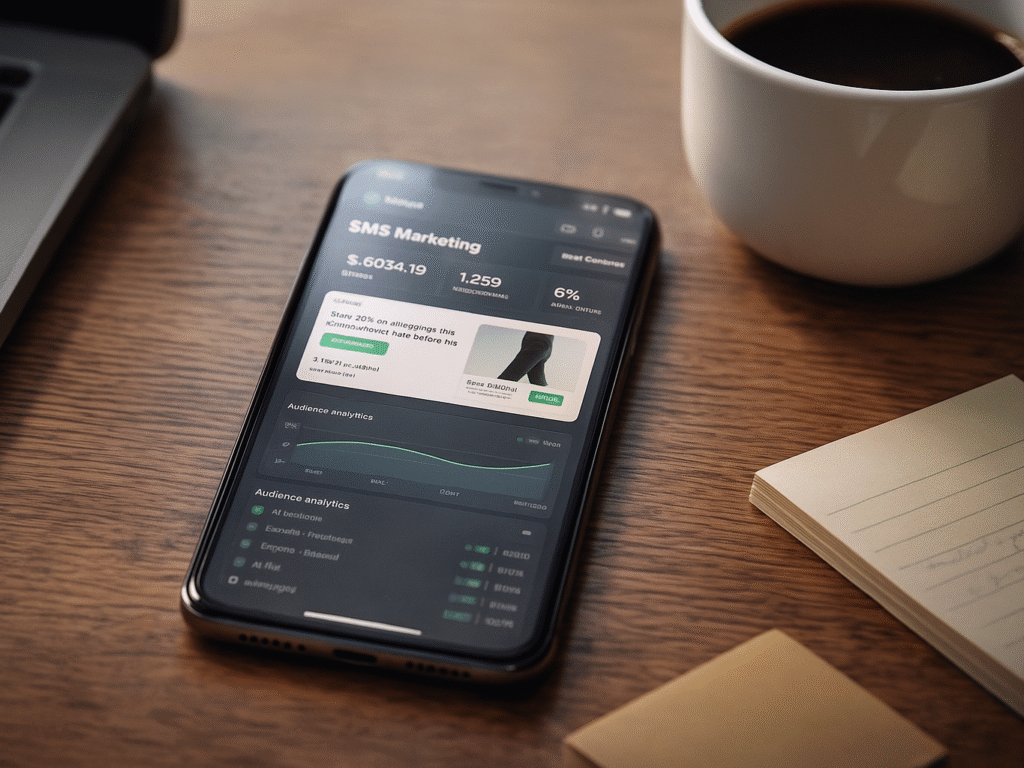
With engagement rates reaching as high as 98%, SMS has quickly become an essential communication Channel for e-commerce businesses. Klaviyo’s SMS marketing capabilities extend beyond basic text messaging, offering WooCommerce store owners powerful tools to connect with customers through their most personal devices.
1. Types of SMS messages supported
Klaviyo supports two primary message formats. First and foremost, standard SMS messages are plain text with a 160-character limit (or 70 characters when including emojis). MMS messages support GIFs and static and dynamic images with a generous 1600-character limit for more visual impact.
In terms of communication types, Klaviyo categorizes SMS messages into three distinct groups:
- Promotional SMS: These messages drive sales, promote products, or build brand awareness. They include new product announcements, special promotions, company news, and event invitations.
- Transactional SMS: Order confirmations, shipping updates, delivery confirmations, and delay notifications fall into this category. Despite focusing on customer service rather than sales, these messages require explicit consent under TCPA regulations.
- Conversational SMS: These interactions go beyond traditional one-way messaging and allow for intelligent responses to customer inputs, preference collection, and real-time recommendations.
2. Consent and opt-in methods
Due to strict regulations, getting proper consent is critical for SMS marketing. Unlike email, having someone’s phone number does not constitute permission to send marketing messages.
Klaviyo offers several sophisticated consent collection methods:
- Smart Opt-in is their most effective approach for list growth. This method keeps shoppers on your site during opt-in, reducing friction through a seamless verification process.
- Tap-to-text: This feature simplifies the subscription process by opening the user’s messaging app with a pre-populated message containing a subscribe keyword.
- SMS subscribe links: Dynamically launch the optimal opt-in experience based on the shopper’s device.
- Consent at checkout: This approach is available for WooCommerce and other e-commerce platforms. This approach lets customers check a box during checkout to opt in.
Most importantly, double opt-in is strongly recommended and required in the US for abandoned cart flows. This two-step verification ensures explicit consent and protects against list bombing.
3. Two-way SMS conversations
The most valuable aspect of Klaviyo’s SMS capabilities is the ability to have real-time conversations with customers. This feature transforms SMS from one-way broadcasts into meaningful dialog.
SMS Conversations enable your brand to see incoming texts and instantly respond to subscribers. When someone replies, you can view their customer profile for context before answering, creating more personalized interactions.
This conversational approach proves remarkably effective for:
- Proactively addressing questions about items in abandoned carts
- Handling inquiries about new product launches
- Offering birthday or anniversary discounts
- Following up after order delivery to gather feedback
Engaging with subscribers through SMS Conversations removes purchase barriers and strengthens customer connections. 72% of customers are more likely to purchase when they can communicate with a business via messaging.
For WooCommerce store owners evaluating Klaviyo, these SMS capabilities provide a direct line to customers that complements email marketing efforts, creating a truly omnichannel experience.
Automation and flows

Automation is the cornerstone of Klaviyo’s powerful marketing arsenal. It enables WooCommerce store owners to create personalized customer journeys without daily manual intervention. By setting up sophisticated sequences that respond to customer behavior, you’ll save countless hours while simultaneously delivering more relevant messages.
1. What are Klaviyo flows?
At its core, a Klaviyo flow is an automated sequence of actions triggered by specific customer behaviors or data points. In Klaviyo terminology, these automated sequences (sometimes called “automation” or “drip campaigns” in other platforms) consist of emails, SMS messages, or other marketing actions that execute automatically based on predefined triggers.
Each flow contains three essential components:
- A trigger that initiates the sequence
- Actions such as sending emails or SMS messages
- Timing delays between actions to create an appropriate cadence
Klaviyo offers five primary types of flow triggers:
- List-triggered flows activate when someone joins a specific list
- Segment-triggered flows launch when someone is added to a segment
- Metric-triggered flows begin when someone takes a particular action, like placing an order or abandoning a cart
- Date property-triggered flows start based on dates in a customer’s profile, such as birthdays
- Price drop-triggered flows initiate when the prices of products a customer viewed decrease in price
2. Pre-built vs. custom flows
Klaviyo excels at providing ready-to-use templates, offering over 60 pre-built, customizable flow templates that help WooCommerce stores implement proven marketing strategies immediately. These templates come with recommended triggers, timing, and even suggested content, making them valuable starting points even for experienced marketers.
Klaviyo’s AI-assisted custom flow creation lets you describe your desired automation. For more advanced needs, it generates a flow structure in seconds. The drag-and-drop builder requires no coding knowledge, enabling you to create complex decision paths and journeys visually.
3. Limitations of flow triggers
Despite their power, Klaviyo flows have several limitations worth noting. First, segment-triggered flows can only be received once per contact, even if someone leaves and rejoins a segment later. Additionally, suppose someone fails a profile filter after entering a flow. In that case, they’ll continue through but be skipped from receiving messages until they exit.
Another consideration for metric-triggered flows is Apple Mail Privacy Protection, which can inflate open rates and potentially disrupt flows triggered by email opens. Furthermore, trigger filters only evaluate data from the triggering event, not profile properties, limiting some targeting options.
Date property triggers require precise timing considerations; if a flow checks a date property immediately after it’s updated, there might be insufficient processing time.
Considering these nuances helps ensure your WooCommerce store maximizes the potential of Klaviyo’s automation capabilities within their natural constraints.
Segmentation and customer data

Effective customer targeting separates basic marketing from exceptional results. Klaviyo’s segmentation features provide WooCommerce store owners with sophisticated audience management tools that deliver personalized experiences at scale.
1. Static lists vs dynamic segments
Fundamentally, Klaviyo organizes your contacts in two distinct ways. Lists are static collections that only grow when people subscribe or are manually added. In contrast, segments are dynamic groupings defined by specific conditions that automatically update in real time.
This difference creates significant marketing advantages. While lists provide a stable record of subscribers, segments constantly evolve based on customer behavior. Consequently, highly segmented campaigns generate more than 3 times the revenue per recipient compared to unsegmented campaigns.
When building segments, Klaviyo provides extraordinary flexibility through its condition-based rules:
- What someone has done (or not done)
- Properties about someone
- Where someone is located
- Predictive analytics about someone
The platform’s AND/OR logic lets you create more exclusive segments (using AND) or more inclusive ones (using OR), giving you precise control over who receives your messages.
2. Behavioral and location-based targeting
Beyond basic demographics, Klaviyo excels at behavioral targeting, allowing you to segment based on virtually any customer action. It includes past purchases, website visits, email engagement, and product page views.
One particularly valuable approach is RFM (recency, frequency, monetary) analysis, which identifies your most valuable customers based on transaction history. In one case study, luxury tea brand Harney & Sons used RFM analysis to target “at-risk” and “needs attention” segments, achieving an average order value 21% higher than their overall e-commerce AOV.
For WooCommerce stores with physical locations, Klaviyo’s proximity-based targeting lets you target customers within specific radii of particular zip codes. This functionality helped luggage brand July target local customers within 20 kilometers of their retail locations, contributing to 52% year-over-year growth in Klaviyo-attributed revenue.
3. Customer profiles and CRM features
Its comprehensive customer data platform is at the core of Klaviyo’s segmentation power. Each profile contains contact information and a complete picture of customer interactions across your tech stack through 350+ integrations.
These detailed profiles include:
- Purchase activity (orders, products, loyalty points)
- Web activity (visits, product views, cart additions)
- Channel engagement across email, SMS, and more
- Custom properties like interests or questionnaire responses
Furthermore, Klaviyo’s B2C CRM capabilities unify marketing, service, and analytics in a single platform. The system’s AI enriches customer data with predictive analytics about churn risk, lifetime value, and expected next order date, enabling you to engage customers before they disengage proactively.
Perhaps most impressively, Klaviyo automatically detects and merges duplicate profiles across multiple devices, ensuring a clear, accurate view of each customer relationship.
Analytics and reporting tools

Data-driven decision-making lies at the heart of Klaviyo’s platform, with powerful analytics tools that help WooCommerce store owners measure, analyze, and optimize their marketing performance across channels.
1. Standard metrics tracked
Klaviyo automatically tracks essential marketing metrics across your campaigns and flows. The platform offers comprehensive performance views through pre-built dashboards that display key indicators, including open rates, click-through rates, conversion rates, and revenue attribution.
These standard metrics are organized by Channel (email, SMS, push notifications) and message type (campaigns vs. flows). The conversion summary card provides a high-level overview of revenue attribution, while the email and SMS funnel summaries show where subscribers drop off in your marketing funnels.
For WooCommerce stores, Klaviyo’s integration captures vital eCommerce data points like placed orders, product views, and checkout starts. It enables accurate tracking of how marketing efforts directly impact your store’s revenue.
2. Custom dashboards and reports
Beyond standard analytics, Klaviyo excels with its custom reporting capabilities. The platform offers five specialized report types to answer specific business questions:
- Single metric deep dive reports for granular analysis of particular metrics
- Multi-metric reports for cross-functional business analysis
- Campaign performance reports for campaign-specific trends
- Flow performance reports for automation effectiveness
- Product performance reports for analyzing product-specific metrics
These reports allow WooCommerce merchants to slice data by various dimensions, including periods, customer segments, and product categories. You can create up to 10 custom dashboards to visualize critical KPIs, each with a date range selector supporting periods from 7 days to 12 months.
3. Predictive analytics and benchmarks
Perhaps most valuable are Klaviyo’s predictive capabilities, which use machine learning to forecast customer behavior. For eligible accounts (those with 500+ customers and 180+ days of order history), Klaviyo generates predictions for:
- Customer lifetime value (historic, predicted, and total)
- Churn risk percentage
- The average time between orders
- Expected date of next order
Klaviyo’s benchmark tools also let you compare your performance against similar businesses in your industry. These benchmarks appear alongside your current values, showing your percentile ranking and status for key metrics. This competitive context helps WooCommerce store owners identify areas of strength and opportunities for improvement in their marketing strategy.
Klaviyo WooCommerce
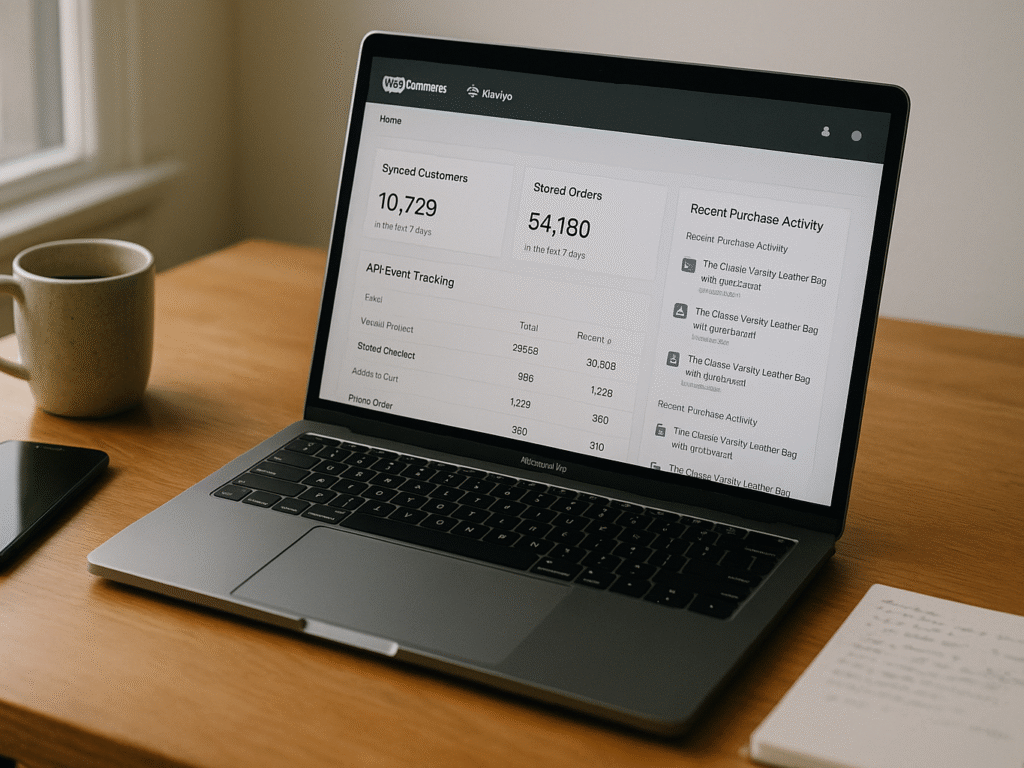
Klaviyo’s WooCommerce integration is one of its most compelling features. It seamlessly bridges your online store and the marketing automation platform. The integration automatically syncs customer data, purchase history, product catalogs, and behavioral triggers, enabling sophisticated e-commerce marketing campaigns without manual data management. WooCommerce store owners can leverage real-time customer insights to create highly targeted segments based on purchase patterns, cart abandonment behavior, and lifetime value calculations.
The integration process typically takes 30 minutes, instantly unlocking powerful eCommerce-specific features like abandoned cart recovery, post-purchase follow-ups, and product recommendation engines. Klaviyo automatically tracks essential WooCommerce events, including product views, cart additions, checkout starts, and order completions, providing comprehensive customer journey visibility. This deep integration enables sophisticated automation workflows that respond to customer behavior in real-time, significantly improving conversion rates and customer retention.
Key WooCommerce Integration Benefits:
- Automated Data Synchronization: Real-time customer profiles, purchase history, and product catalog updates eliminate manual data entry and ensure marketing accuracy.
- Advanced eCommerce Tracking: Comprehensive behavioral monitoring, including product views, cart activities, and purchase patterns, enables precise customer journey mapping.
- Revenue Attribution Accuracy: Direct integration provides precise tracking of marketing campaign impact on sales, enabling data-driven optimization and ROI measurement.
This Klaviyo review highlights how the WooCommerce integration transforms basic email marketing into sophisticated customer relationship management, making it an invaluable tool for serious eCommerce businesses seeking automated, personalized marketing solutions.
Ease of use and learning curve
When evaluating any marketing software, ease of use often determines whether you’ll stick with it long-term. Klaviyo offers a mixed experience that reflects its powerful capabilities, balanced against a learning curve that some users find challenging.
1. Initial setup experience
The onboarding process begins with a personalized setup wizard that collects information about your business to customize your experience. Klaviyo recently improved this wizard, reducing the completion time from 4 minutes to under 5 minutes for most users. Indeed, after these improvements, approximately 70% of new users complete setup within one hour of signing up (up from 60%).
The guided setup includes practical time estimates for each task: connecting your business platforms takes about 30 minutes, turning on website tracking requires roughly 5 minutes, and importing contacts requires approximately 10 minutes. For WooCommerce users, the integration process is generally straightforward; nevertheless, some users report occasional connection issues that require workarounds.
2. User interface overview
Once past the initial setup, you’ll navigate Klaviyo through a clean, minimalist interface. The dashboard arranges features neatly on the left side, making it relatively easy to switch between different functions. With this in mind, first-time users should prepare for initial navigation challenges, primarily because Klaviyo packs numerous features into its platform.
The email editor offers a user-friendly experience with drag-and-drop functionality, allowing quick customization of layouts and elements. Creating personalized emails with images, text blocks, and buttons typically takes just a few minutes, even for beginners.
3. Learning resources and academy
Recognizing the platform’s complexity, Klaviyo offers extensive educational resources through Klaviyo Academy. These include:
- Quick guides for learning key strategies in 15 minutes or less
- Comprehensive courses with practical examples
- Best practices based on business goals
- Live training with over 60 sessions monthly across various time zones and languages
First, remember that Klaviyo offers a product certification program that tests your knowledge and awards a certificate upon completion. Meanwhile, the Klaviyo Community provides forums where users can post questions and receive answers from experienced users.
These resources prove essential for WooCommerce store owners looking to maximize Klaviyo’s potential. The platform’s advanced features often require dedicated learning time before yielding their full value.
Klaviyo pros and cons
After exploring this Klaviyo Review in-depth, weigh its strengths and weaknesses to determine whether it’s the right fit for your WooCommerce store.
1. Top advantages
Klaviyo shines with its extensive third-party integrations and responsive email templates that adapt beautifully across devices. The platform’s segmentation capabilities enable highly targeted campaigns that generate 3× more revenue per recipient than unsegmented messages. For WooCommerce users, the seamless integration process typically takes 30 minutes to create a unified customer data environment.
Chiefly, Klaviyo’s automated workflows save countless hours while maintaining personalized communication. One eCommerce brand reported capturing over $100,000 in revenue from a single abandoned cart flow alone. Furthermore, top-performing brands using Klaviyo have experienced up to 400% increases in cart recovery rates.
2. Common complaints
Correspondingly, Klaviyo’s powerful features come with several drawbacks. The platform is relatively expensive compared to competitors, potentially straining budgets for smaller WooCommerce stores. Before committing to Klaviyo’s premium pricing, it’s worth exploring our detailed Klaviyo vs ActiveCampaign comparison to understand alternative pricing structures and feature offerings. Users frequently report customer support issues, including long wait times for email and live chat assistance, with no phone support option available.
New users face a steep learning curve when mastering Klaviyo’s advanced features, particularly when setting up complex segments. The lack of a dedicated landing page builder and limited design options (compared to some competitors) can hinder specific marketing strategies.
3. Is Klaviyo worth it?
Klaviyo’s value proposition ultimately depends on your business size and email marketing goals. With over 100,000 eCommerce brands using the platform globally, many find the investment justified by the returns. According to industry research, email marketing generates an average ROI of $42 for every $1 spent. Klaviyo’s advanced features can help achieve or exceed this benchmark.
For established WooCommerce stores focused on customer retention and lifecycle marketing, Klaviyo typically delivers excellent results. Nonetheless, businesses with tight budgets or just starting might find better value in more affordable alternatives until their contact lists and revenue justify Klaviyo’s premium pricing.
Top Klaviyo alternatives to consider
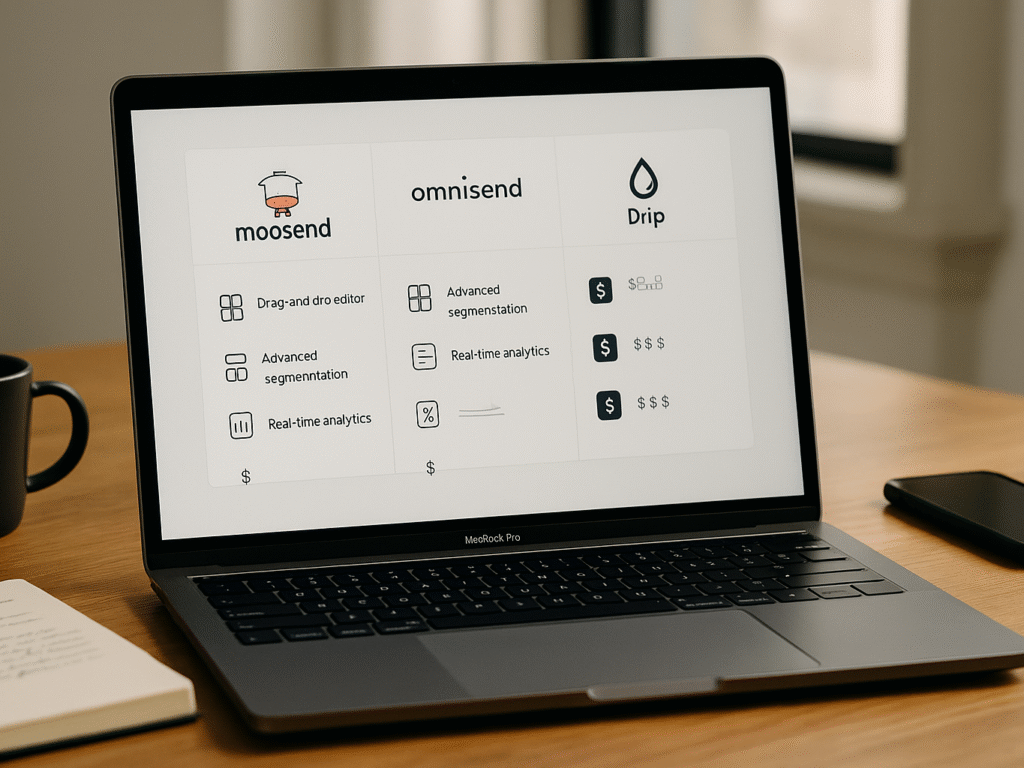
While Klaviyo offers powerful features for eCommerce businesses, Klaviyo alternatives might reveal platforms better suited to your specific needs and budget. For an in-depth feature and pricing analysis, our comprehensive Klaviyo vs ActiveCampaign comparison highlights key differences between these popular platforms. Here’s a look at three top competitors for your WooCommerce store.
1. Moosend
Moosend positions itself as an affordable yet comprehensive email marketing solution for small businesses and agencies. The platform offers AI-powered product recommendations, advanced segmentation tools, real-time analytics tracking, landing page builders, and subscription form tools without enterprise-level pricing.
Many users praise Moosend for its user-friendly interface and quick setup time. As one G2 user notes, “Very generous free trial period (30 days), with no branding on emails. Affordable rates even if you’re experimenting.” The platform provides excellent customer support, described by some reviewers as “AMAZING, top-notch.”
2. Omnisend
Primarily designed for eCommerce teams who aren’t necessarily full-time marketers, Omnisend bundles everything into a drag-and-drop platform that’s powerful without being overwhelming. Fundamentally, what sets Omnisend apart is that all plans include all features, you only upgrade when your list size requires it.
Compared to Klaviyo, Omnisend offers more affordable pricing while maintaining comparable eCommerce features. The platform includes:
- Native web push notifications (up to 500 pushes/month on the free plan)
- A unique “Wheel of Fortune” gamified pop-up for email collection
- SMS marketing capabilities with international support
- Email + SMS + web push in unified sequences
A global photography backdrop company, Kate Backdrop achieved a remarkable 1:300 ROI after switching from Klaviyo to Omnisend.
3. Drip
Essentially, Drip positions itself as a user-friendly platform that eliminates unnecessary complexity while delivering powerful automation features. One of its most distinctive advantages is its tag-based approach to contact management, which allows marketers to categorize subscribers based on behaviors and preferences.
Drip excels for businesses prioritizing simplicity and quick implementation. Its intuitive interface enables marketers to launch effective campaigns without extensive training.
4. When to choose an alternative
Consider switching from Klaviyo if you find its pricing too expensive for your budget, struggle with its steep learning curve, or need more intuitive interfaces. Each alternative offers unique strengths: Moosend for affordability, Omnisend for omnichannel marketing, and Drip for simplicity, making them viable options depending on your WooCommerce store’s specific requirements.
ConvertKit Review: Everything You Need to Know About Pricing, Features and Plans Considering ConvertKit as your email marketing solution? Our comprehensive review covers everything from pricing tiers to advanced features, helping creators and businesses choose the perfect platform for their audience growth strategy.
Conclusion
This in-depth Klaviyo review shows why it’s a powerful marketing automation platform for eCommerce and a great choice for WooCommerce store owners. Its seamless integration enables advanced segmentation, targeted automations, and dynamic messaging that turns customer data into revenue-driving marketing.
Despite premium pricing, many WooCommerce merchants find Klaviyo’s strong features worth the investment. Its ability to deliver up to 3× more revenue per recipient through segmented campaigns often outweighs costs. However, smaller stores should assess their scale and marketing needs, as mastering Klaviyo’s learning curve requires time and effort.
Klaviyo excels in customer retention and lifecycle marketing with advanced automation and predictive analytics. It suits established WooCommerce stores with healthy margins seeking sophisticated marketing tools. Newer businesses might start with affordable alternatives until growth and revenue justify Klaviyo’s powerful capabilities for driving consistent customer engagement.
FAQs klaviyo-review
Q1. What are the pricing tiers for Klaviyo?
Klaviyo offers three pricing tiers: a free plan for up to 250 contacts, an Email plan starting at $20/month for 500 contacts, and an Email + SMS plan starting at $35/month with 1,250 SMS/MMS credits included.
Q2. Who is Klaviyo best suited for?
Klaviyo works best for e-commerce businesses such as direct-to-consumer brands, subscription services, and small to medium-sized companies in fashion, beauty, health supplements, and other industries that need advanced segmentation and personalized customer communication.
Q3. What are some key features of Klaviyo?
Klaviyo offers email marketing with drag-and-drop editing, SMS marketing, mobile app marketing, customer segmentation, automated workflows, advanced analytics, and reporting tools designed to help businesses personalize marketing efforts and drive revenue.
Q4. How does Klaviyo compare to traditional email tools?
Compared to traditional email tools, Klaviyo delivers a highly integrated, data-driven experience. It provides advanced automation, personalization, eCommerce-specific features, and powerful segmentation to help businesses better target customers and improve marketing performance.


